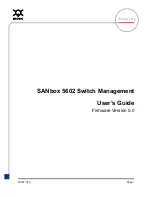
Command Line Interface
4-104
4
Otherwise, you need to manually create a known hosts file on the management
station and place the host public key in it. An entry for a public key in the known
hosts file would appear similar to the following example:
10.1.0.54 1024 35 15684995401867669259333946775054617325313674890836547254
15020245593199868544358361651999923329781766065830956 10825913212890233
76546801726272571413428762941301196195566782 59566410486957427888146206
51941746772984865468615717739390164779355942303577413098022737087794545
24083971752646358058176716709574804776117
3.
Import Client’s Public Key to the Switch – Use the
copy tftp public-key
command
to copy a file containing the public key for all the SSH client’s granted
management access to the switch. (Note that these clients must be configured
locally on the switch with the
username
command as described on page 4-77.)
The clients are subsequently authenticated using these keys. The current
firmware only accepts public key files based on standard UNIX format as shown
in the following example for an RSA Version 1 key:
1024 35 1341081685609893921040944920155425347631641921872958921143173880
05553616163105177594083868631109291232226828519254374603100937187721199
69631781366277414168985132049117204830339254324101637997592371449011938
00609025394840848271781943722884025331159521348610229029789827213532671
31629432532818915045306393916643 [email protected]
4.
Set the Optional Parameters – Set other optional parameters, including the
authentication timeout, the number of retries, and the server key size.
5.
Enable SSH Service – Use the
ip ssh server
command to enable the SSH
server on the switch.
6. Authentication
– One of the following authentication methods is employed:
Password Authentication (for SSH v1.5 or V2 Clients)
a) The client sends its password to the server.
b) The switch compares the client's password to those stored in memory.
c) If a match is found, the connection is allowed.
Note:
To use SSH with only password authentication, the host public key must still be
given to the client, either during initial connection or manually entered into the
known host file. However, you do not need to configure the client’s keys.
Public Key Authentication
– When an SSH client attempts to contact the switch,
the SSH server uses the host key pair to negotiate a session key and encryption
method. Only clients that have a private key corresponding to the public keys
stored on the switch can access it. The following exchanges take place during
this process:
Authenticating SSH v1.5 Clients
a) The client sends its RSA public key to the switch.
b) The switch compares the client's public key to those stored in memory.
c) If a match is found, the switch uses its secret key to generate a random
256-bit string as a challenge, encrypts this string with the user’s public key,
and sends it to the client.
Содержание 8126PL2-F
Страница 1: ...MANAGEMENT GUIDE ta TigerSwitchTM 10 100 1000 L2 Lite SMB PoE Gigabit Switch SMC8126PL2 F ...
Страница 2: ......
Страница 6: ...vi ...
Страница 22: ...Contents xxii ...
Страница 26: ...Tables xxvi ...
Страница 48: ...Initial Configuration 2 10 2 ...
Страница 117: ...User Authentication 3 69 3 Web Click Security AAA Summary Figure 3 43 AAA Accounting Summary ...
Страница 590: ...Command Line Interface 4 302 4 ...
Страница 604: ...Glossary Glossary 8 ...
Страница 612: ...Index 8 Index ...
Страница 613: ......
Страница 614: ...149100000023A R01 SMC8126PL2 F ...
















































